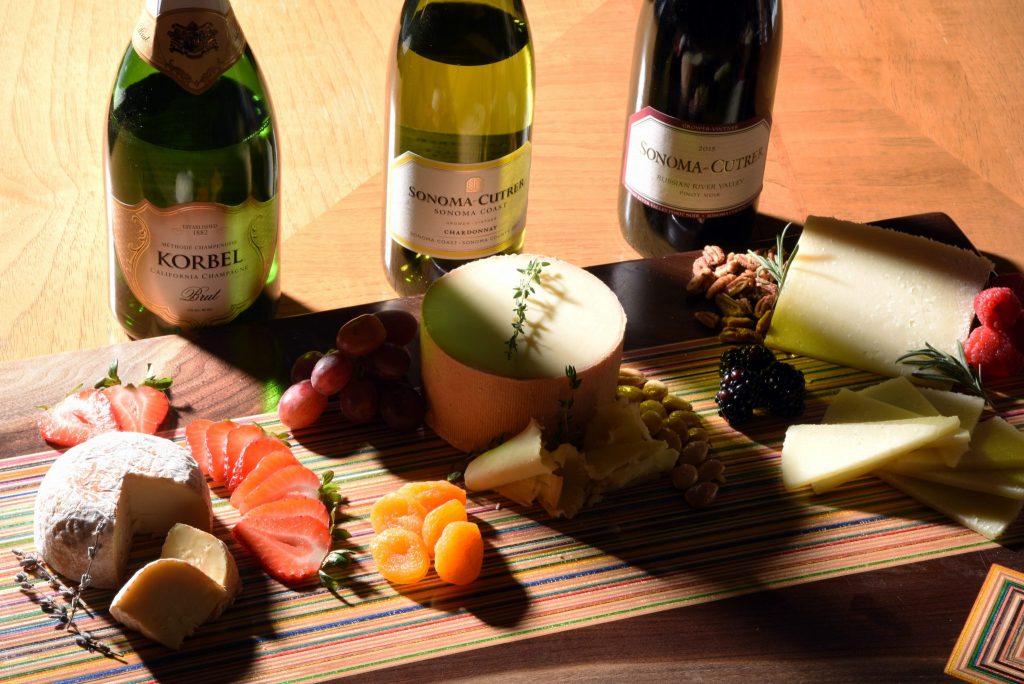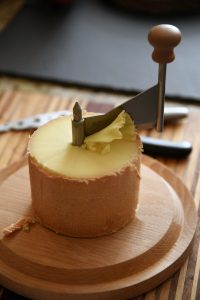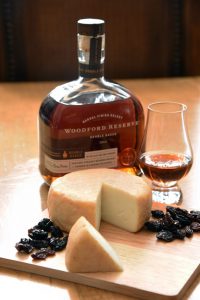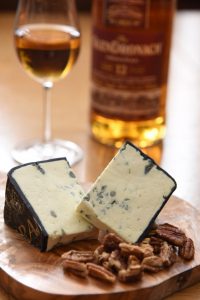The great American food writer M.F.K. Fisher once said, “Wine and cheese are ageless companions, like aspirin and aches, or June and moon, or good people and noble ventures.”
This time of year, there are few ventures more noble than gathering friends, family, and neighbors for a cheese and wine party. It’s an experiential occasion that gets everyone into the act. When wine is correctly paired with food, the wine makes the food taste better and food makes the wine taste better. Anytime we’re planning a party or gathering, we think it’s wise to consult an expert, so we asked Cheesemonger Adam “Chubs” Steckler of Harvey’s Cheese in the new Logan Street Market to search through the offerings at Harvey’s and put together cheese boards appropriate for a few different scenarios.
(Originally published in the Winter 2019 issue of Food & Dining)
In fact, we asked Steckler to give us advice in planning five different kinds of social gatherings. He came back with some great suggestions — and great tasting notes for all his recommended cheese boards. Steckler gave us the lists, storage tips, and tasting notes (adding tasting notes to your board is a great idea!). And we added some tips that will help you plan a successful and fun cheese and wine party. By the way, just in case you can’t find the specific cheeses Steckler recommends, we’ve included great traditional pairings that never fail.
We love all these ideas, and we think you and your guests will, too!
Here is what our guest Cheesemonger had to say.
A Party Cheese Board
(8-12 guests)

Passive cheese boards (stand-alone boards that aren’t part of a larger menu) are always fun to play around with. You’re not necessarily pairing anything with the cheeses, so it’s your time to have fun and put out interesting combinations.
When building a cheese board I like to follow a few basic guidelines: vary your textures, play with colors, and switch up your milk types. Traditionally I go for a 3 cheese board consisting of a soft spreadable cheese, a hard cheese, and a wild card which is normally a blue or goat cheese. For this board, for our “soft,” we chose a Fromage D’affinois, a rich, buttery, double crème cheese. Our “hard” cheese isn’t actually all that hard. It’s Windsor Red, an English cheddar that derives tons of color and character from being marbled with Port wine and brandy. And our wild card cheese is Buffarolo, a buffalo milk, taleggio-style cheese that’s cave-aged in Brooklyn, NY. The pulp of this cheese is big and beefy with just a hint of musk. It’s a little stinky and delightfully irresistible. We also laid out a fair amount of fresh and dried fruits and nuts on this board as a palate cleanser — eating too much cheese alone will fatigue your taste buds.
I like to leave all of my crackers off the cheese board and really let the cheese itself shine. Don’t overthink your crackers. Simple black pepper or sea salt crackers are perfect for any cheese board. I love seeded and fruited crackers, but they will fall flat when really trying to capture the nuances of a cheese you’ve never had. Also try serving a crusty baguette on the side with aged balsamic vinegar or an olive oil and spice dip.
A Wine and Cheese Pairing Party
(6-8 guests)

Start things off with Champagne and Cowgirl Creamery’s Red Hawk and some strawberries. This triple cream, washed-rind brings a little funk to the party. The sweetness from the strawberries brings out the hidden delicacy and creaminess in an otherwise stinky cheese. Paired with a sparking glass of wine, this will be sure to please your guests. Or you can serve with champagne instead and wow your guests!
■ Traditional champagne pairing: Camembert

Use a Chardonnay as your second wine, and match it up with Tete de Moine, a rich, slightly pungent small format, unpasteurized cow cheese from Switzerland. This is a great traditional cheese that’s been made since before 1200 AD. It’s great when served in the traditional manner: “rosettes.” Shaving these small, rose shaped flowers from the top of the cheese which aerates it and brings the full flavor profile to the forefront. Add some honey and glistening, juicy red pomegranate arils for color and zing. And go bold, with a big oaky chardonnay.
■ Traditional champagne pairing: Chevre (goat cheese)
Finish up your party with a Pinot Noir and Manchego, which makes a delicious match. Manchego is a Spanish sheep’s milk cheese. For this occasion, we opted for a young, unpasteurized version (aged four months). This is a great pairing: sheep’s milk has rich
fat that cuts through tannins like a hot knife.
You might also pair this cheese with a spicy Spanish red or a Tempranillo varietal.
■ Traditional champagne pairing: Anything sheep
By the way, when in doubt, it’s a great idea to pair wines and cheeses that are produced in the same region. It’s not the only way to pair, but it’s a great start.

Cheese for a Date Night
(2 guests)
Jasper Hill Harbison is the cheese you never knew you always wanted. Working in a cheese shop you find that men and women often times have the same approach to cheese for date night: soft buttery cheese with sweet sugary jam. I think this works and is wonderful, but not all cheeses need sweet accompaniments. Harbison has a complex woodsy taste that comes from the spruce bark it’s wrapped in. Let this cheese come up to room temperature, cut the top off, and serve with a spoon. Pair this cheese with pickles, salamis, crusty bread, your favorite strong mustard, and the beverage of your choice. This is an intriguing cheese you and your partner won’t soon forget.

For a Bourbon and Cheese Pairing
(2-4 guests)
We live in the land of bourbon, and this combination is one of our all-time favorites: Woodford Double Oaked paired with Mont Saint Francis, produced by Capriole Cheese in Greenville Indiana, about 30 minutes north of Louisville. This goat cheese is hand-washed with dark beer, then aged to perfection. It’s a strong cheese with a touch of sweetness that admirably holds its ground against the wood and slight smoke that comes from this amazing bourbon.

For a Scotch and Cheese Pairing
(2-4 guests)
This one was a surprise. We paired Gran Noir Blue with Glendronach 12-year-old Highland Single Malt Scotch Whisky. Gran Noir blue is a German blue with a decadence unlike any other. It eats like a buttery triple crème cheese. I love this cheese with scotch, but Wow! This scotch was unlike any I had ever tasted. There was almost no sign of peat on my palate and a good amount of sweet. This pairing is fantastic but might be slightly too sweet for some palates. A double crème brie would also be fantastic with this scotch and the Gran Noir could stand up against a scotch with more peat.
Storing Cheese
• Keep the cheese wrapped so it doesn’t dry out when storing. Unwrap it just before serving. Wrap and refrigerate any leftover cheese as soon as possible.
• Plastic wrap is acceptable for wrapping cheese. To allow the cheese to breathe and keep it from discoloring the wrap should be changed every few days.
• Different types of cheese require different methods of storage:
• Hard cheeses with little moisture (Parmesan) should be wrapped tightly in plastic wrap to avoid further moisture loss.
• Semi-hard cheeses (Cheddar, Jack, Swiss) can be wrapped in either plastic wrap, wax paper or parchment paper.
• Semi-soft cheese (Brie, Blue) should be wrapped in wax paper or parchment paper, or may be kept in a plastic container.
• Soft or fresh cheeses (Ricotta, Feta) should be kept in a plastic container.
Tips on hosting a wine and cheese party
• Offer a wide selection of white and red wines so your guests can experiment with many flavors.
• Set out the cheeses at least two hours ahead so they have time to come to room temperature and exhibit their full flavor.
• Plate the cheeses with their own serving knife and leave enough space between the cheeses so the flavors do not blend.
• Use cheese markers so your guests know what type of cheese they are tasting.
• Use a glass that can multi-task for both white and red wines. This would be a standard wine glass or one of your larger white wine glasses.
• Place wine charms on the glasses so your guests can keep track of their glass.
• Set out a pitcher of water and a dump bucket so your guests can rinse their glass after each wine they try.
• When tasting, you will want to pour just enough wine in the glass to have about two or three sips to try with a couple bites of cheese. This way each guest can try several combinations.
• Plan on approximately 12 – 15 tasting pours per bottle of wine.
• Sample the wines and cheeses from light to heavy. Start with the white wines and then move into the reds.
• Set out many different crackers and light bites to help cleanse the palate after each tasting.
• Plate an assortment of fresh fruit to compliment the cheeses such as: seedless grapes, apples and pears.
• Nuts, especially walnuts, cashews and almonds will pair well with the wines, too.
• Encourage your guests to talk about their wine and cheese experience after they sip and taste.
• Poll who liked which pairings the best and have your guests keep a record of their favorites.
• Experiment with our “Basic Guide” to get a sense of what a great pairing can do for wine and cheese. Then try your own experiments!
Must-Try Wine Pairing Guide
Sauvignon Blanc with goat cheese: Both of these items are slightly acidic and have a strong taste. When you try them together, the wine tastes creamier and the cheese tastes milder.
Chardonnay with Fontina: The cheese can be pungent with an intense flavor, this pairing makes both the wine and cheese taste creamy and lush.
Cabernet Sauvignon Blanc with Blue Cheese: Both the wine and the cheese have big bold flavors. Sampled together, the wine tames the blue cheese and the cheese makes the wine taste velvety smooth. What happens is the fat content of the cheese mellows the tannins in the wine and the wine makes the blue cheese soft and creamy.
For a sweet treat try a couple bites of dark bittersweet chocolate with the cabernet. It is truly a wonderful marriage of food and wine. To make a festive dessert, rim a red wine glass in melted chocolate, let set and when it’s dessert time fill it with cabernet.
A Basic Guide to Other Wine Pairings
Blue — Cabernet Sauvignon, Shiraz or Zinfandel
Brie — Chardonnay or Pinot Noir
Cheddar — Riesling, Sauvignon Blanc, Merlot or Shiraz
Gouda — Riesling, Merlot or Zinfandel
Gruyere — Chardonnay, Riesling, Sauvignon Blanc or Shiraz
Monterey Jack — Riesling, Sauvignon Blanc or Merlot
Parmigiano Reggiano — Chardonnay, Sauvignon Blanc, Cabernet Sauvignon or Merlot
Swiss — Sauvignon Blanc, Cabernet Sauvignon or Pinot Noir F&D



















